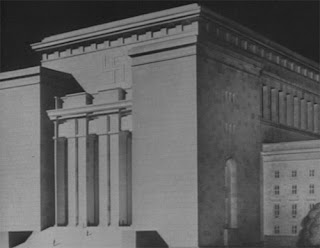'Every structure left to us by history expresses the spirit of it's builder.
Brutaliat in Stein: Die Ewigkeit von Gestern (1960) [Brutality in Stone: Yesterday Goes on for Ever] is an experimental film by Alexander Kluge (b.1932). It depicts the abandoned Nazi architecture, strikingly void of human life and disturbingly illustrates the utilization of inhuman and super-human scale that attempted to bolster the political regime of the same. Shots of huge neo-classical architectural structures from the Nazi period are confronted with equally anti-human national-socialist language as a voice-over. Kluge intersperses the film footage from the early 1960s with various images dating from 1933 to 1945, including photographs of Adolf Hitler drawing building plans, his personal sketches, and drawings of reconceived German cities.
http://www.youtube.com/watch?v=islUtYwOOx8&feature=player_embedded'
Alexander Kluge is a German filmmaker and author, published in English by Seagull Books.
Brutaliat in Stein: Die Ewigkeit von Gestern (1960) [Brutality in Stone: Yesterday Goes on for Ever] is an experimental film by Alexander Kluge (b.1932). It depicts the abandoned Nazi architecture, strikingly void of human life and disturbingly illustrates the utilization of inhuman and super-human scale that attempted to bolster the political regime of the same. Shots of huge neo-classical architectural structures from the Nazi period are confronted with equally anti-human national-socialist language as a voice-over. Kluge intersperses the film footage from the early 1960s with various images dating from 1933 to 1945, including photographs of Adolf Hitler drawing building plans, his personal sketches, and drawings of reconceived German cities.
http://www.youtube.com/watch?v=islUtYwOOx8&feature=player_embedded'
Alexander Kluge is a German filmmaker and author, published in English by Seagull Books.





